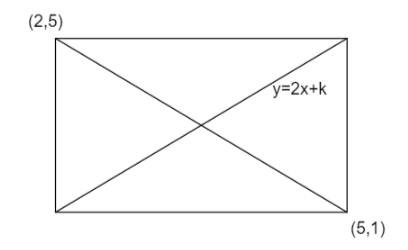
The points (2, 5) and (5, 1) are two opposite vertices of a rectangle. If the other two vertices are points on the straight line \[y = 2x + k\] , then find the value of k.
A. 4
B. 3
C. -4
D. -3
Answer
216.3k+ views
Hints First draw the rectangle with the stated information. Then obtain the mid-point of (2, 5) and (5, 1). The given line passes through the mid-point so, substitute the values of x and y as the obtained mid-point and obtain the value of k.
Formula used
The mid-point of a line with end vertices \[(a,b),(c,d)\] is \[\left( {\dfrac{{a + c}}{2},\dfrac{{b + d}}{2}} \right)\] .
Complete step by step solution
The diagram of the given problem is,

Image: Rectangle
The midpoint of the diagonal with vertices (2, 5) and (5, 1) is
\[\left( {\dfrac{{2 + 5}}{2},\dfrac{{5 + 1}}{2}} \right)\]
\[ = \left( {\dfrac{7}{2},3} \right)\]
From the diagram it is clear that the mid-point is on the given line.
Therefore,
\[3 = 2 \times \dfrac{7}{2} + k\]
\[3 = 7 + k\]
\[k = - 4\]
The correct option is C.
Additional information
The internal angles of a rectangle, which has four sides, are all exactly 90 degrees. At each corner or vertex, the two sides come together at a straight angle. The rectangle differs from a square because its two opposite sides are of equal length.
Note Students sometimes did not understand the fact the given line is the equation of the diagonal line as it is given as -the other two vertices are points of the line \[y = 2x + k\] . But the opposite vertices cannot be the points of a line other than the diagonal, it is clear from the given diagram.
Formula used
The mid-point of a line with end vertices \[(a,b),(c,d)\] is \[\left( {\dfrac{{a + c}}{2},\dfrac{{b + d}}{2}} \right)\] .
Complete step by step solution
The diagram of the given problem is,

Image: Rectangle
The midpoint of the diagonal with vertices (2, 5) and (5, 1) is
\[\left( {\dfrac{{2 + 5}}{2},\dfrac{{5 + 1}}{2}} \right)\]
\[ = \left( {\dfrac{7}{2},3} \right)\]
From the diagram it is clear that the mid-point is on the given line.
Therefore,
\[3 = 2 \times \dfrac{7}{2} + k\]
\[3 = 7 + k\]
\[k = - 4\]
The correct option is C.
Additional information
The internal angles of a rectangle, which has four sides, are all exactly 90 degrees. At each corner or vertex, the two sides come together at a straight angle. The rectangle differs from a square because its two opposite sides are of equal length.
Note Students sometimes did not understand the fact the given line is the equation of the diagonal line as it is given as -the other two vertices are points of the line \[y = 2x + k\] . But the opposite vertices cannot be the points of a line other than the diagonal, it is clear from the given diagram.
Recently Updated Pages
JEE Main 2024 (January 24 Shift 1) Question Paper with Solutions [PDF]

Progressive Wave: Meaning, Types & Examples Explained

Temperature Dependence of Resistivity Explained

JEE Main 2024 (January 25 Shift 1) Physics Question Paper with Solutions [PDF]

Difference Between Vectors and Scalars: JEE Main 2026

Salt Hydrolysis IIT JEE | Aсіdіtу and Alkаlіnіtу of Sаlt Sоlutіоns JEE Chemistry

Trending doubts
JEE Main 2026: Application Form Open, Exam Dates, Syllabus, Eligibility & Question Papers

JEE Main 2026 Chapter-Wise Syllabus for Physics, Chemistry and Maths – Download PDF

JEE Main Previous Year Question Paper with Answer Keys and Solutions

Understanding Newton’s Laws of Motion

JEE Main Cut Off 2026 - Expected Qualifying Marks and Percentile Category Wise

Marks vs Percentile JEE Mains 2026: Calculate Percentile Marks

Other Pages
NCERT Solutions For Class 10 Maths Chapter 12 Surface Area And Volume

NCERT Solutions for Class 10 Maths Chapter Chapter 13 Statistics

NCERT Solutions for Class 10 Maths Chapter 11 Areas Related to Circles 2025-26

Pregnancy Week and Due Date Calculator: Find How Far Along You Are

NCERT Solutions for Class 10 Maths Chapter 15 Probability

Complete List of Class 10 Maths Formulas (Chapterwise)




